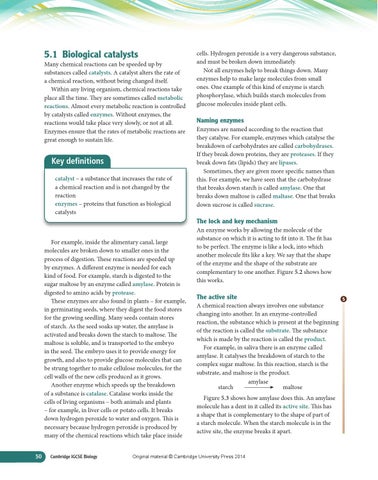5.1 Biological catalysts
Many chemical reactions can be speeded up by substances called catalysts. A catalyst alters the rate of a chemical reaction, without being changed itself. Within any living organism, chemical reactions take place all the time. They are sometimes called metabolic reactions. Almost every metabolic reaction is controlled by catalysts called enzymes. Without enzymes, the reactions would take place very slowly, or not at all. Enzymes ensure that the rates of metabolic reactions are great enough to sustain life.
Key definitions catalyst – a substance that increases the rate of a chemical reaction and is not changed by the reaction enzymes – proteins that function as biological catalysts
cells. Hydrogen peroxide is a very dangerous substance, and must be broken down immediately. Not all enzymes help to break things down. Many enzymes help to make large molecules from small ones. One example of this kind of enzyme is starch phosphorylase, which builds starch molecules from glucose molecules inside plant cells.
Naming enzymes Enzymes are named according to the reaction that they catalyse. For example, enzymes which catalyse the breakdown of carbohydrates are called carbohydrases. If they break down proteins, they are proteases. If they break down fats (lipids) they are lipases. Sometimes, they are given more specific names than this. For example, we have seen that the carbohydrase that breaks down starch is called amylase. One that breaks down maltose is called maltase. One that breaks down sucrose is called sucrase.
The lock and key mechanism For example, inside the alimentary canal, large molecules are broken down to smaller ones in the process of digestion. These reactions are speeded up by enzymes. A different enzyme is needed for each kind of food. For example, starch is digested to the sugar maltose by an enzyme called amylase. Protein is digested to amino acids by protease. These enzymes are also found in plants – for example, in germinating seeds, where they digest the food stores for the growing seedling. Many seeds contain stores of starch. As the seed soaks up water, the amylase is activated and breaks down the starch to maltose. The maltose is soluble, and is transported to the embryo in the seed. The embryo uses it to provide energy for growth, and also to provide glucose molecules that can be strung together to make cellulose molecules, for the cell walls of the new cells produced as it grows. Another enzyme which speeds up the breakdown of a substance is catalase. Catalase works inside the cells of living organisms – both animals and plants – for example, in liver cells or potato cells. It breaks down hydrogen peroxide to water and oxygen. This is necessary because hydrogen peroxide is produced by many of the chemical reactions which take place inside 50
Cambridge IGCSE Biology
An enzyme works by allowing the molecule of the substance on which it is acting to fit into it. The fit has to be perfect. The enzyme is like a lock, into which another molecule fits like a key. We say that the shape of the enzyme and the shape of the substrate are complementary to one another. Figure 5.2 shows how this works.
The active site A chemical reaction always involves one substance changing into another. In an enzyme-controlled reaction, the substance which is present at the beginning of the reaction is called the substrate. The substance which is made by the reaction is called the product. For example, in saliva there is an enzyme called amylase. It catalyses the breakdown of starch to the complex sugar maltose. In this reaction, starch is the substrate, and maltose is the product. amylase starch maltose Figure 5.3 shows how amylase does this. An amylase molecule has a dent in it called its active site. This has a shape that is complementary to the shape of part of a starch molecule. When the starch molecule is in the active site, the enzyme breaks it apart.
Original material © Cambridge University Press 2014
S
